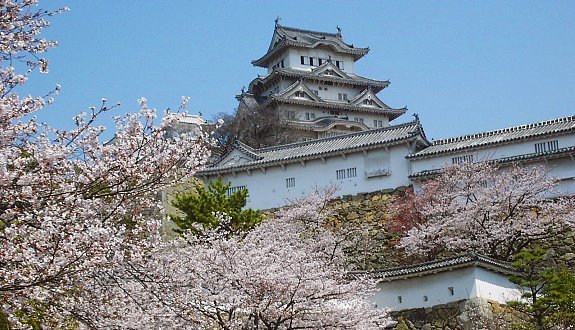 Himeji Castle
Himeji Castle
History of Japanese Castles
Fortresses have been built in Japan since early times. A particular need for castles arouse in the 15th century after the central government's authority had weakened and Japan had fallen into the chaotic era of warring states (sengoku jidai). During that era, Japan consisted of dozens of small independent states which fought each other and built small castles on top of mountains for defense purposes.
When Oda Nobunaga reestablished a central authority over Japan in the second half of the 16th century, and his successor Toyotomi Hideyoshi completed the reunification of Japan, many larger castles were built across the country. Unlike the earlier castles, they were built in the plains or on small hills in the plains, where they served as a region's administrative and military headquarters and a symbol of authority. They became the centers of "castle towns".
After the end of the feudal age (1868), many castles were destroyed as unwelcome relics of the past, and even more were lost in World War II. Only about a dozen original castles, i.e. castles that date from the feudal era (before 1868), survive today. Furthermore, several dozen castles were reconstructed over the past decades - mostly using concrete instead of traditional building materials.
Castle Structures and Castle Towns
The typical castle consisted of multiple rings of defense, with the so called honmaru ("main circle") in the center followed by the ninomaru ("second circle") and sannomaru ("third circle"). The castle tower stood in the honmaru, while the lords usually lived at a more comfortable residence in the ninomaru.
In the town around the castle, the samurai were residing. The higher their rank, the closer they lived to the castle. Merchants and artisans lived in specially designated areas, while temple and entertainment districts were usually located in the outskirts of the city or just outside of it. Tokyo and Kanazawa are two good examples among many Japanese cities which evolved as castle towns.
The main construction material for castle buildings used to be wood, as can be witnessed when visiting the interior of one of the surviving original castles. Most newer reconstructions, however, were made of concrete, and their interiors are modern. Many castles now house a museum.
The following are some typical castle structures:
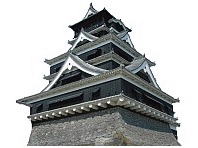 Castle Tower (Tenshukaku) Also known as donjon or castle keep, this is the innermost, best defended and most prominent structure of a castle. Most castle towers have between two to five stories, and there are often more floors inside than there are stories on the outside. Example: castle tower of Kumamoto Castle
Castle Tower (Tenshukaku) Also known as donjon or castle keep, this is the innermost, best defended and most prominent structure of a castle. Most castle towers have between two to five stories, and there are often more floors inside than there are stories on the outside. Example: castle tower of Kumamoto Castle 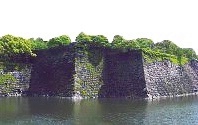 Walls and Moats Several rings of walls and moats serve as the main defense measure of castles. Osaka Castle and the former Edo Castle (now Tokyo's Imperial Palace) offer the most impressive examples. Example: Castle walls and moat of Osaka Castle
Walls and Moats Several rings of walls and moats serve as the main defense measure of castles. Osaka Castle and the former Edo Castle (now Tokyo's Imperial Palace) offer the most impressive examples. Example: Castle walls and moat of Osaka Castle 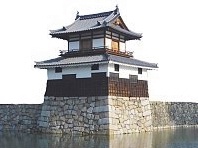 Guard Towers (Yagura) Also known as turrets, these are watch towers and storage rooms along the castle walls, often placed at the corners. Castles usually have multiple guard towers. They are much smaller in size than the main castle tower and are usually made up of two floors. Example: a guard tower of Hiroshima Castle
Guard Towers (Yagura) Also known as turrets, these are watch towers and storage rooms along the castle walls, often placed at the corners. Castles usually have multiple guard towers. They are much smaller in size than the main castle tower and are usually made up of two floors. Example: a guard tower of Hiroshima Castle 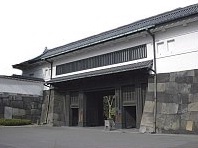 Gates Castles have a number of well defended entrance gates. The typical castle gate consists of two gates which are placed at a 90 degree angle to each other, creating a small inner yard which is heavily defended from all sides. Example: Sakurada Gate of the former Edo Castle
Gates Castles have a number of well defended entrance gates. The typical castle gate consists of two gates which are placed at a 90 degree angle to each other, creating a small inner yard which is heavily defended from all sides. Example: Sakurada Gate of the former Edo Castle 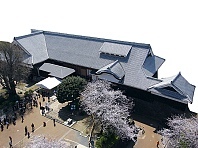 Palace (Goten) The palace houses the lord's residence and offices. Most castles have lost their palace over time. A rare surviving example is the Ninomaru Palace of Nijo Castle. Among the few castles with reconstructed palaces are Kumamoto Castle, Hikone Castle and Nagoya Castle.
Palace (Goten) The palace houses the lord's residence and offices. Most castles have lost their palace over time. A rare surviving example is the Ninomaru Palace of Nijo Castle. Among the few castles with reconstructed palaces are Kumamoto Castle, Hikone Castle and Nagoya Castle.
Japanese Castle History covers the different periods of building, developing and destruction of Japanese castle.
Though they were built to last, and used more stone in their construction than most Japanese buildings, castles were still constructed primarily of wood, and many were destroyed over the years. This was especially true during the Sengoku ('Warring States') period (1467-1603), when many of these castles were first built. However, many were rebuilt, either later in the Sengoku period, in the Edo period (1603-1867) which followed, or more recently, as national heritage sites or museums. Today, there are around fifty castles extant, or partially extant, in Japan; it is estimated that once there were five thousand. Some castles, such as the ones at Matsue and Kōchi, both built in 1611, remain extant in their original forms, not having suffered any damage from siege or other threats. Hiroshima Castle, on the opposite end of the spectrum, was destroyed in the atomic bombing, and was rebuilt in 1958 as a museum.
The character '城', normally read as shiro, is read as jō when it is attached to a word, such as in the name of a particular castle. Thus, for example, Osaka Castle is called ōsaka-jō (大阪城) in Japanese.

Japanese Castle
Picture: Himeji Castle - the best example of a Japanese Castle
Japanese Castles - History
Originally conceived of purely as fortresses, their primary purpose being military defence, Japanese castles were originally placed in strategic locations, along trade routes, roads and rivers. Though castles continued to be built with these considerations in mind, for centuries fortresses were also built to serve as centers of governance. By the Sengoku period, they had come to serve as the homes of daimyo (feudal lords), and served to impress and intimidate rivals not only with their defences, but with their size and elegant interiors, architecture and decorations. Oda Nobunaga was one of the first to build one of these palace-like castles, at Azuchi Castle in 1576; this was Japan's first castle to have a tower keep (天守閣, tenshukaku), and it inspired both Toyotomi Hideyoshi's Osaka Castle and Tokugawa Ieyasu's Edo Castle.[3] Azuchi served as the governing center of Oda's territories, and as his lavish home, but it was also very keenly and strategically placed. A short distance away from the capital of Kyoto, which had long been a target of violence, Azuchi's carefully chosen location allowed it a great degree of control over the transportation and communication routes of Oda's enemies.
Prior to the Sengoku period (roughly, the 16th century), most castles were called yamashiro (山城), or 'mountain castles'. Though most later castles were built atop mountains or hills, these were built from the mountains. Trees and other foliage were cleared, and the stone and dirt of the mountain itself was carved into rough fortifications. Ditches were dug, to present obstacles to attackers, as well as to allow boulders to be rolled down at attackers. Moats were created by diverting mountain streams. Buildings were made primarily of wattle and daub, using thatched roofs, or, occasionally, wooden shingles. Small ports in the walls or planks could be used to deploy bows or fire guns from. The main weakness of this style was its general instability. Thatch caught fire even more easily than wood, and weather and soil erosion prevented structures from being particularly large or heavy. Eventually, stone bases began to be used, encasing the hilltop in a layer of fine pebbles, and then a layer of larger rocks over that, with no mortar. The character for castle or fortress (城), up until sometime in the 9th century or later, was read (pronounced) ki, as in this example, mizuki.
Though fairly basic in construction and appearance, these wooden and earthwork structures were designed to impress just as much as to function effectively against attack. Chinese and Korean architecture strongly influenced the design of Japanese buildings, including fortifications, in this period. The remains or ruins of some of these fortresses, decidedly different from what would come later, can still be seen in certain parts of Kyushu and Tohoku today.
Japanese Castles - Heian Period
The Heian period (794-1185) saw a shift from the need to defend the entire state from invaders to that of lords defending individual mansions or territories from one another. Though battles were still continually fought in the north-east portion of Honshū (the Tōhoku region) against native peoples, the rise of the samurai warrior class[5] towards the end of the period, and various disputes between noble families jostling for power and influence in the Imperial Court brought about further developments. The primary defensive concern in the archipelago was no longer native tribes or foreign invaders, but rather internal conflicts within Japan, between rival samurai clans or other increasingly large and powerful factions, and as a result, defensive strategies and attitudes were forced to change and adapt. As factions emerged and loyalties shifted, clans and factions which had been allies in the service of the Imperial Court became enemies, and defensive networks were broken, or altered through the shifting of alliances.
The Genpei War (1180-1185) between the Minamoto and Taira clans, and the Nanboku-chō Wars (1336-1392) between the Northern and Southern Imperial Courts are the primary conflicts that define these developments during what it sometimes called Japan's medieval period.
Fortifications were still built almost entirely out of wood, and were based largely on earlier modes, and on Chinese and Korean examples. But they began to become larger, to incorporate more buildings, to accommodate larger armies, and to be conceived as more permanent structures. This mode of fortification, developed gradually from earlier modes and used throughout the wars of the Heian period (770-1185), and deployed to help defend the shores of Kyushu from the Mongol invasions of the 13th century, reached its climax in the 1330s, during the Nanboku-chō period. Chihaya castle and Akasaka castle, permanent castle complexes containing a number of buildings but no tall keep towers, and surrounded by wooden walls, were built by Kusunoki Masashige to be as militarily effective as possible, within the technology and designs of the time.
The Ashikaga shogunate, established in the 1330s, had a tenuous grip on the archipelago, and maintained relative peace for over a century. Castle design and organization continued to develop under the Ashikaga shogunate, and throughout the Sengoku period. Castle complexes became fairly elaborate, containing a number of structures, some of which were quite complex internally, as they now served as residences, command centers, and a number of other purposes.
Japanese Castles - Sengoku
The Ōnin War which broke out in 1467, however, marked the beginning of a period of nearly 150 years of widespread warfare (called the Sengoku period) between daimyō (feudal lords) across the entire archipelago. For the duration of the Ōnin War (1467-1477), and into the Sengoku period, the entire city of Kyoto became a battlefield, and suffered extensive damage. Noble family mansions across the city became increasingly fortified over this ten year period, and attempts were made to isolate the city as a whole from the marauding armies of samurai which would dominate the landscape for over a century.[7]
As regional officials and others became the daimyō, and the country descended into war, they began to quickly add to their power bases, securing their primary residences, and constructing additional fortifications in tactically advantageous or important locations. Originally conceived as purely defensive (martial) structures, or as retirement bunkers where a lord could safely ride out periods of violence in his lands, over the course of the Sengoku period, many of these mountain castles developed into permanent residences, with elaborate exteriors and lavish interiors.
The beginnings of the shapes and styles now considered to be stereotypical "classic" Japanese castle design emerged at this time, and castle towns (城下町, jōkamachi, lit. "town below castle") also appeared, grew and developed. Despite these developments, though, for most of the Sengoku period castles remained essentially larger, more complex versions of the simple wooden fortifications of centuries earlier. It was not until the last thirty years of the period of war that drastic changes would occur to bring about the emergence of the type of castle typified by Himeji Castle, the Imperial Palace, and other castles surviving today. This period of war culminated in the Azuchi-Momoyama period, which saw some of the largest battles in the pre-modern world, and saw great advances in military technology, strategy and tactics.
Japanese Castles - Azuchi-Momoyama period
Unlike in Europe, where the advent of cannon spelled the end of the age of castles, Japanese castle-building was spurred, ironically, by the introduction of firearms. Though firearms first appeared in Japan in 1543, and castle design almost immediately saw developments in reaction, Azuchi castle, built in the 1570s, was the first example of a largely new type of castle, on a larger, grander scale than those which came before, boasting a large stone base (武者返し, musha-gaeshi), a complex arrangement of concentric baileys (丸, maru), and a tall central tower. In addition, the castle was located on a plain, rather than on a densely forested mountain, and relied more heavily on architecture and manmade defenses than on its natural environment for protection. These features, along with the general appearance and organization of the Japanese castle, which had matured by this point, have come to define the stereotypical Japanese castle. Along with Hideyoshi's Fushimi-Momoyama castle, Azuchi lends its name to the brief Azuchi-Momoyama period (roughly 1568-1600) in which these types of castles, used for military defense, flourished.
The introduction of the arquebus brought dramatic shifts in battle tactics and military attitudes in Japan. Though these shifts were complex and numerous, one of the concepts key to changes in castle design at this time was that of battle at range. Though archery duels traditionally preceded samurai battles since the Heian period or earlier, exchanges of fire with arquebuses had a far more dramatic effect on the outcome of the battle; hand-to-hand fighting, while still extremely common, was diminished by the coordinated use of firearms.
Oda Nobunaga, one of the most expert commanders in the coordinated tactical use of the new weapon, built his Azuchi castle, which has since come to be seen as the paradigm of the new phase of castle design, with these considerations in mind. The stone foundation resisted damage from arquebus balls better than wood or earthworks, and the overall larger scale of the complex added to the difficulty of destroying it. Tall towers and the castle's location on a plain provided greater visibility from which the garrison could employ their guns, and the complex set of courtyards and baileys provided additional opportunities for defenders to retake portions of the castle that had fallen.
Cannon were rare in Japan due to the expense of obtaining them from foreigners, and the difficulty in casting such weapons themselves as the foundries used to make bronze temple bells were simply unsuited to the production of iron or steel cannon. The few cannon that were used were smaller and weaker than those used in European sieges, and many of them were in fact taken from European ships and remounted to serve on land; where the advent of cannon and other artillery brought an end to stone castles in Europe, wooden ones would remain in Japan for several centuries longer. A few castles boasted 'wall guns', but these are presumed to be little more than glorified arquebuses, lacking the power of a true cannon. When siege weapons were used in Japan, they were most often trebuchets or catapults in the Chinese style, and they were used as anti-personnel weapons.
Japanese Castles - Edo Period
The Sengoku period, roughly a century and a half of war which saw great changes and developments in military tactics and equipment, as well as the emergence of the Azuchi-Momoyama style castle, was followed by the Edo period, over two hundred and fifty years of peace, beginning around 1600-1615 and ending in 1868. Edo period castles, including those which survived from the preceding Azuchi-Momoyama period, therefore no longer had defence against outside forces as their primary purpose. Rather, they served primarily as luxurious homes for the daimyō, their families and retainers, and to protect the daimyō, and his power base, against peasant uprisings and other internal insurrections. The Tokugawa shogunate, in order to forestall the amassing of power on the part of the daimyō, enforced a number of regulations limiting the number of castles to one per han (feudal domain), with a few exceptions,[9] and a number of other policies including that of sankin kōtai. Though there were also, at times, restrictions on the size and furnishings of these castles, and many daimyō grew quite poor later in the period, daimyō nevertheless sought as much as possible to use their castles as representations of their power and wealth. The general architectural style did not change much from more martial times, but the furnishings and indoor arrangements could be quite lavish.
This restriction on the number of castles allowed each han had profound effects not only politically, as intended, but socially, and in terms of the castles themselves. Where members of the samurai class had previously lived in or around the great number of castles sprinkling the landscape, they now became concentrated in the capitals of the han and in Edo; the resulting concentration of samurai in the cities, and their near-total absence from the countryside and from cities that were not feudal capitals (Kyoto and Osaka in particular) were important features of the social and cultural landscape of the Edo period. Meanwhile, the castles in the han capitals inevitably expanded, not only to accommodate the increased number of samurai they now had to support, but also to represent the prestige and power of the daimyō, now consolidated into a single castle. Edo castle, expanded by a factor of twenty between roughly 1600 and 1636 after becoming the shogunal seat, though obviously something of an exception, the shogun not being a regular daimyō, nevertheless serves as a fine example of these developments. These vastly consolidated and expanded castles, and the great number of samurai living, by necessity, in and around them, thus led to an explosion in urban growth in 17th century Japan.
As contact with Western powers increased in the middle of the 19th century, some castles such as Goryōkaku castle in Hokkaido were turned once again to martial purposes. No longer needed to resist samurai cavalry charges, or arquebus squads, attempts were made to convert Goryōkaku, and a handful of other castles across the country, into defensible positions against the cannon of Western naval vessels.
Japanese Castles - Modern Japan
All castles, along with the feudal domains themselves, were turned over to the Meiji government in the 1871 abolition of the han system, but few if any were destroyed at that time. Many of the castles remaining in Japan today are reconstructions, some of them made primarily of concrete and designed only to represent or resemble the original wooden structures. Nevertheless, all castles, along with a number of sites of historical or natural significance, are protected under a series of laws promulgated for that purpose. The first came in 1919, and was followed ten years later by the 1929 National Treasure Preservation Law.
Many castles were destroyed in World War II, along with much of their surrounding cities. Those which survived were declared National Treasures of Japan in 1951. Many of those destroyed were rebuilt, and some were reopened as museums.

Japanese Castle - Osaka Castle
https://www.youtube.com/watch?v=zmnOI4xmv8U
HIMEJI CASTLE
5M
https://www.youtube.com/watch?v=T5CSC7waAsM
HIMEJI CASTLE2
15M
https://www.youtube.com/watch?v=JDiqLK5TZ90
NIJO CASTLE
16M
https://www.youtube.com/watch?v=fKCMaoP3BHo
ROYAL JAPAN PALACE
10M
https://www.youtube.com/watch?v=F9cZIllRmcE
Medieval castles in Russia
Staraya Ladoga Fortress

The Staraya Ladoga village used to be a prosperous trading outpost in the 8th and 9th centuries. A multi-ethnic settlement, it was dominated by Scandinavians who were called by the name of Rus and for that reason is sometimes called the first capital of Russia. The village was referred in 862 for the first time in ancient annals concerning calling of three Varangian Rurick brothers as crisis managers for the Russia Land, ...
Founded: ca. 1114 | Location: Staraja Ladoga, Russia | Photo copyright: Solnyshkov
Ragnit Castle Ruins

On 23rd April 1289 the Landmeister (provincial Master) of the Teutonic Order in Prussia, Meinhard von Querfurt, attacked the lands of the Skalvians. Afterwards he ordered to construct a Teutonic fortress which was to replace an old Prussian fort called "Ragaine". The new stronghold was named "Landehut", meaning "the land"s guarding fort" or "the land"s defence". At the tu ...
Founded: 1397-1409 | Location: Neman, Russia | Photo copyright: Kenan2
Preußisch Eylau Castle

In 1325, the Teutonic Knights built a castle called 'Yladia' or 'Ilaw', later known as 'Preussisch Eylau', in the center of the Old Prussian region Natangia. Ylow is the Old Prussian term for mud or swamp. The settlement nearby developed slowly, but in 1348 the Teutonic Order gave the privilege to establish twelve pubs at the surrounding area of the castle. Even though the village had only a ...
Founded: 1325 | Location: Bagrationovsky, Russia | Photo copyright: eugene.erin
Korela Fortress

Korela Fortress, at the town of Priozersk, was founded by the Karelians who named the place Käkisalmi. It was first mentioned in a Novgorodian chronicle of 1143 as Korela. Indeed, archeological digs have revealed a layer belonging to the 12th century. Swedish chronicles first reported of the settlement of Keksholm in 1294. Until the 16th century, the fortress belonged to the Novgorod Republic, followed by Muscovy. No ...
Founded: 1143 | Location: Priozersk, Russia | Photo copyright: Sergey Nesterenko
Ivangorod Fortress

Ivangorod Fortress is a Russian medieval castle established by Moscovian Grand Prince Ivan III in 1492 and since then grown into the town of Ivangorod. The castle is strictly quadrilateral with walls 14 meters tall. The original castle was constructed in one summer. Its purpose was to fend off the Livonian Knights. The castle is strictly quadrilateral with walls 14 meters tall. Iva ...
Founded: 1492 | Location: Ivangorod, Russia | Photo copyright: Konstantin Yolshin
Gerdauen Castle Ruins

The earth and timber stronghold Gerdauen was constructed by the Teutonic Knights in 1270. After a subsequent Prussian uprising, the Knights were too weak to keep hold of all their fortresses. Gerdauen was burnt down, but once the Prussian uprising was put down, the Teutonic Knights returned here and began to raise new fortifications. By 1310, a new stronghold had been completed. At that time it was guarded by embankments, ...
Founded: 1270 | Location: Kaliningrad Oblast, Russia | Photo copyright: Kenan2
Nizhny Novgorod Kremlin

The first attempt to replace the wooden fort on the stone Kremlin in the historic city center of Nizhny Novgorod refers to 1374, but construction limited to only one tower, known as the Tower of Dmitrov (not survived to our time). Under the rule of Ivan III, Nizhny Novgorod plays the role of guard city, having a standing army, and serves as a place of military gathering troops on Moscow"s actions against Khanate of K ...
Founded: 1500 | Location: Nizhny Novgorod, Russia | Photo copyright: shotlandka
Balga Castle Ruins

Balga was a medieval castle of the Teutonic Knights. The hill of Balga had been the site of an Old Prussian (Warmian) fortress called Honeda, that had been unsuccessfully besieged by the Wettin margrave Henry III of Meissen on his 1237 Prussian Crusade. It was conquered in 1239 by the forces of the Teutonic Order, led by Grand Marshal Dietrich von Bernheim. The oldest Ordensburg constructed by the Teutonic Order was buil ...
Founded: 1239 | Location: Kaliningrad Oblast, Russia | Photo copyright: Kenan2
Labiau Castle Ruins

The earliest mention of Labiau dates back to 1258. At that time Labiau was most probably an old Baltic Prussian village or a small fortified settlement. The first timber fortress was built by the Teutonic Knights during the second Prussian surge, around the year 1274 (other sources suggest that the first stronghold was established in 1258). It stood at the mouth of the Laba River and protected this waterway. During the Pr ...
Founded: 1360 | Location: Polessk, Russia | Photo copyright: Kenan2
Vyborg Castle

Vyborg Castle was one of the three major castles of Finland. It was built as the easternmost outpost of the medieval Kingdom of Sweden: it is located on the Karelian isthmus, on a little islet in the innermost corner of the Gulf of Finland. It was originally constructed in the 1290s. The town was originally located inside the outer fortifications of the castle, at the fortress island, but it had to be moved to its present ...
Founded: 1293 | Location: Vyborg, Russia | Photo copyright: ahvalj
Shlisselburg Fortress

Shlisselburg (originally Schlüsselburg or Nöteborg) was one of the most important medieval fortresses in the northwest Russia. It is located to the head of the Neva River on Lake Ladoga. Today the fortress and the city center are UNESCO World Heritage Sites. The first fortification was built by Swedes in 1299 but was lost to the Novgorodians in 1301. A wooden fortress named Oreshek was built by Grand Prince Yur ...
Founded: 1299 | Location: Shlisselburg, Russia | Photo copyright: S.Sosnovskiy
Brandenburg Castle Ruins

The Battle of Pokarwis between pagan Prussians and the Teutonic Knights took place nearby in 1261. The Teutonic Knights founded the village as Brandenburg to honor Otto III, Margrave of Brandenburg who supported the order in the Prussian Crusade, and erected a castle in 1266. Today impressive ruins remains.
Founded: 1266 | Location: Ushakovo, Russia | Photo copyright: Wargen
Koporye Castle Ruins

Koporye contains some of the most impressive medieval ruins in Russia. The first wooden fortress on the coast of the Koporye Bay was built by the Teutonic Knights in 1240, only to be destroyed by Alexander Nevsky the next year. The second fortress was built in stone by Alexander's son Dmitry Alexandrovich in 1280. Enraged by the prince's independence, the Novgorodians razed the fortress two years later. Meanwhile the Swe ...
Founded: 1240-1297 | Location: Koporye, Russia | Photo copyright: Hohlick
Schaaken Castle Ruins

Schaaken Castle, built by Teutonic Order, was first mentioned in 1328. Today impressive ruins remain of this brick castle.
Founded: 1328 | Location: Niekrasowo, Russia | Photo copyright: Stina_K
Izborsk Fortress

Izborsk contains one of the most ancient and impressive fortresses of Western Russia. According to the Russian Primary Chronicle, the town was the seat of Rurik's brother Truvor from 862-864. Although his burial mound is still shown to occasional tourists, archaeological excavations of long barrows abounding in the vicinity did not reveal the presence of the Varangian settlement at the site, indicating that Izborsk was an ...
Founded: 1302 | Location: Izborsk, Russia | Photo copyright: GlobalHeritageFund
Insterburg Castle Ruins

In 1311, Teutonic mercenaries called Landsknechts set up a camp on the high banks of the Angrapa River, close to where it flows into the Inster River. Later, in 1337, the Teutonic Knights built a brick castle in the same location. Most of the construction works had been completed by 1347. The fortress was named Insterburg Castle. For many centuries to follow, Insterburg Castle was a bastion located in the easternmost par ...
Founded: 1337 | Location: Chernyakhovsky, Russia | Photo copyright: cheshirkgd
Pskov Krom

The Pskov Krom (or Pskov Kremlin) is an ancient citadel in Pskov. In the central part of the city, the Krom is located at the junction of the Velikaya River and smaller Pskova river. The citadel is of medieval origin, with the surrounding walls constructed starting in the late 1400s. The Krom was the administrative and spiritual centre of the Pskov Republic in the 15th century. In 2010, two of the towers of seven (the Vla ...
Founded: 15th century | Location: Pskov, Russia | Photo copyright: ankorsoft
Gremyachaya Tower

Gremyachaya or Gremjatšaja Tower was a defensive keep built by Vasili III of Russia in 1525. The six-storey tower is 20m high and 15m wide.
Founded: 1525 | Location: Pskov, Russia | Photo copyright: petr.pustota
Waldau Castle Ruins

The earliest official mention of building a fortress in Waldau comes from a chronicle dating to 1258. The name of the castle derives from the Baltic Prussian language, where it meant "to own". And in fact, the surrounding lands belonged to two Prussian landowners: Brulant and Diabel, who were called "tenants" or "dukes". In 1264, the dukes were obliged by the Teutonic Knights to set up an inn ...
Founded: 1258 | Location: Nizov'e, Russia | Photo copyright: Kenan2
Saalau Castle Ruins

The Knights of the Teutonic Order appeared on this land in 1257. In 1352, when the Prussian lands were divided between the Church and the Monastic Order, Saalau and the surrounding lands were ceded to the Church. In 1355, the Church had already built here a Chapter House, known as the Cathedral Chancery. The building however was burnt down several times during Lithuanian raids. So in 1376 the Church authorities made a dec ...
Founded: 1376 | Location: Chernyakhovsk, Russia | Photo copyright: Kenan2
Gdov Kremlin

Gdov was established as an outpost of the Pskov Republic. It occupied a strategically important position, being close to Lake Peipus, separating Livonia and Rus. Located on an important road to Pskov, Gdov protected it from the north. Its first mention in the chronicles dates back to 1323. Initially, the fortress was a mixture of wooden and earthen fortifications. However, the level of protection was deemed insuffici ...
Founded: 1431-1434 | Location: Gdov, Russia | Photo copyright: kylepounds2001
Neuhausen Castle Ruins

The first reliable mention of Neuhausen dates back to 1292, when Bishop Christian von Mühlhausen ordered to raise a fortified castle in this location. Following the reformation of the Catholic Church in Prussia in 1525 the castle became a property of Albrecht Hohenzollern of Brandenburg. The Duke had the castle completely redesigned, converting it into a suburban hunters manor. In 1550, when the Duke had made a decis ...
Founded: 1292 | Location: Guryevsky, Russia
Suzdal Kremlin

The Suzdal Kremlin is the oldest part of the Russian city of Suzdal, dating from the 10th century. Like other Russian Kremlins, it was originally a fortress or citadel and was the religious and administrative center of the city. It is most notably the site of the Cathedral of the Nativity. Together with several structures in the neighboring city of Vladimir, it was named a UNESCO World Heritage Site in 1992. While archeo ...
Founded: 11th century | Location: Suzdal, Russia | Photo copyright: yustoprst
KREMLIN 1 15M
https://www.youtube.com/watch?v=CDqeGb1l2fU
KREMLIN 2 15M
https://www.youtube.com/watch?v=Z-pkYqLZIRs
KREMLIN 3 15M
https://www.youtube.com/watch?v=vLGnm4E8VcY